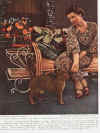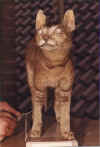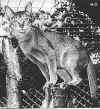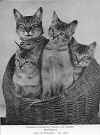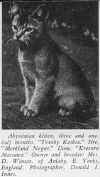Historical Abyssinian Photos
The
photos and photocopies shown here come from the archives of Nile Abyssinians.
Photo Index
1.
Zula (c. 1872)
2.
Ch Southampton Red Rust
(1923)
3.
Ch Woodrooffe Ras Seyum
(1938)
4.
Abyssinian? Cat
in Leyden Museum (pre 1834)
5.
Int
Ch Assunta von Ras-Daschan (1961)
6.
Ch Kreeoro Sheba (1950)
7. Tranby Kashta (1954)
8.
Abyssinian
Cat (pre-1903)
9. Sedgemere Peaty (b. 1894)
10. Woodrooffe Zeus (1932)
11. St. Vincent's Aida (1935)
12. Croham Menelik (1936)
13.
Sun
Dance Autumn Mist (1970)
1.
Zula
The woodcut below comes from a photocopy of the mid 1870s book page that mentions and pictures the Abyssinian cat for the first time.
This is a photocopy of a page from a May 25, 1923 issue of what must surely be Fur & Feather, containing a photo and a brief description of "A 'Bunny' Cat", Ch Southampton Red Rust (b. 07-Sep-20) from Ch Ras Dashan and Queen of Sheba.
3. Ch (Djer-Mer's) Woodrooffe Ras Seyum (UK-USA)
This is a scanned-in original, colour plate XVII from the article "The Panther of the Hearth" which appeared in the National Geographic Magazine in November 1938. It shows Miss Mary Hantzmon with her imported English stud, Ch Woodrooffe Ras Seyum. Unfortunately the picture tries to take in the furniture, flower arrangement and the owner, but the cat does get a reasonable look in. I made sure that the colours on my screen were a good match for the original, so if you think you are seeing a well coloured cat, that's how he appears in the National Geographic photo.Ch (Djer-Mer's) Woodrooffe Ras Seyum (UK-USA) {TWN} was bred and exported by Major E. Sydney Woodiwiss. He was born on 21-Sep-35, and registered GCCF 24057 & CFA 18-FR-215. His sire was Tim The Harvester (son of Ras Brouk) and his dam was Woodrooffe Aura. Like Ch Southampton Red Rust above, he appears behind most if not all modern-day Abys and Somalis.
4. Aby-like Cat in Dutch Museum
These photos were provided by the late Harry Blok, back in 1985, and published in an early issue of The Abyssinian Breeder Magazine. They show the famous stuffed cat at the National Museum of Natural History (Rijksmuseum van Natuurlijke Historie) in Leiden, just north of The Hague in The Netherlands. What you see below is an accurate reproduction of the colour balance, hue and saturation of the photos which, I was assured, are equally accurate reproductions of the original. The height at the shoulder is about 25 cm, the length of body plus head is about 48 cm and the tail length is 28 cm . A cat of that size is estimated to weigh a little over 3 kg. Although this is not shown on the photos, the cat is said to have a close-lying coat, some patches of grey undercoat, a spine line ending in a black tail tip, and some black on the back of the hind legs. Note also the total absence of white under the chin and around the nostrils.
The exact provenance of this cat is unknown. What is known is that it came to the museum as a skin, and hence, if the shape does not appear quite right, that may be because the taxidermist did not know what it should have been. Analysis of what records there are indicates that the specimen was acquired by the museum no later than 1833-34, and that it quite probably came from India.
Call me (George Kennedy) naive or romantic, but it looks like an Aby to me, with excellent colour and ticking .
5. Int Ch Assunta von Ras-Daschan
Judging by the little information and very few photos extant, she must have been an excellent cat for her time. This is shown in the photo below, though her ears might be regarded as being placed a little too high by modern standards.
Assunta von Ras-Daschan was bred in Germany and born on 7-Dec-1960; no other Ras-Daschan cats appear on modern Abyssinian or Somali pedigrees. Her sire was the Swedish bred Int Ch Snorrehus James who effectively was an all-Nigella (UK) cat. Where it gets interesting is that Assunta's dam was the German Centa vom OriŽnt, whose sire was the mysterious Mischa von Manila, a circus cat said to have been imported into Germany from the Philippines.
Assunta had a major influence on the Abyssinian breed. She was one of the four foundation cats for Mrs Maria Falkena-RŲhrle's MariŽndaal cattery in the Netherlands. MariŽndaal cats were to be found everywhere in Europe for many years; no fewer than eight went to USA and one even found her way to Australia in the mid 1960s. Assunta was the dam of seven breeding MariŽndaal cats, including two of the most commonly used studs of their time, International Champions Emir and Muchacho van MariŽndaal. Who knows which of our cats' characteristics originated in her unorthodox ancestry?
The photo below was scanned and kindly provided by Dr. Julia Craig-McFeely, Project Manager of the Digital Image Archive of Medieval Music at the University of London. The original source was P M Soderberg: Pedigree Cats, Their Varieties, Breeding and Exhibition (London, 1958).
The photo shows the English Tawny female, Ch Kreeoro Sheba and three kittens.
Sheba was bred by Dr. H. Wildeboer, an early post World War II Aby pioneer. She
was born on 15-May-1950, from the mating of Kreeoro Iyasu and Kreeoro Zana. The
well-known and influential Kreeoro Massawa, owned by Mrs Dorothy Winsor, was
Sheba's litter sister.
The photo of Kashta was also kindly provided by Julia; this time the source is A C Jude: Cat Genetics (Jersey City, 1967).
This photo of Tranby Kashta, a Tawny English male bred by Mrs Dorothy Winsor, was taken when he was 3Ĺ months old. Born on 19-Jan-1954, Kashta came from a mating of the very influential Merkland Negus and Kreeoro Massawa (see above). Tranby Kashta was himself a quite significant cat. He was the sire of Raby Honey, an early Cinnamon, and indeed Mrs Winsor was a world pioneer of Cinnamons; she sent them as far away as Europe, USA, New Zealand and Australia. Kashta was the grandsire Ch Harmony Tara, a member of the first trio of breeding Abyssinians who arrived in Australia in 1959.
Frances Simpson wrote a book called "The Book of the Cat", published in the UK in 1903. It was a famous book in its time, with excellent pictures. The photo below is the illustration showing the Aby (left) and "Indian" cats.
From the same sources as the preceding picture, comes a photo that includes the famous Sedgemere Peaty (far right). Both photos are reprinted from the ACF Inc Judges' Guild Journal, "Felijudge", May 2001 edition, with permission from Lesley Morgan Blythe. Sedgemere Peaty, a Tawny female, b. Oct 1894, Reg. NCC 2315 (S. & D. unknown) has no modern descendants, as far as can be ascertained.
She was bred by "Anon." and owned initially by Mr Swinyard, then Mr Sam Woodiwiss, and finally Mr H.C. Brooke who, in his April 1929 book, The Abyssinian Cat, wrote "Probably the best Abyssinians ever seen in this country (UK) were Sedgemere Bottle and Sedgemere Peaty, the property of Mr Sam Woodiwiss. ... Peaty ended her days in my possession, and I have always regretted not having preserved her skin to at least retain her glorious colour, though her beautiful sinuous form and delicate limbs can barely be imagined by those who have not seen her."
Provided by Lesley Morgan Blythe, this photo comes from a 1937 issue of the UK publication "Cats and Kittens". Zeus was born on 13-May-1932, and hence five years old in this photo. He was bred in the UK by Mrs E. Buffard (one of the several breeders who registered kittens under the Woodrooffe cattery name principally owned by Major E. Sydney Woodiwiss), and exported to Mme L. Guyot in France. A very successful show cat, Zeus had wins at shows in Paris, Geneva, Copenhagen, Turin and Nancy. He was used for breeding, notably by Mme Guyot (de LignŤre cattery in St Cloud), and Mw Kreunen-Mees (van d'Arke Noachs cattery) who bred the first Abys in the Netherlands. He has no modern descendants because of the disruption caused by World War II, but his lines are fully represented among modern Abys and Somalis.
Note that his name is mis-spelled in the photo caption below!
This photo comes from the same sources as No. 10, and similarly shows a mid-1930s Tawny Abyssinian who has no modern descendants. St. Vincent's Aida was one of a series of cats bred by Mrs I. Cavenaugh from Ch Billibun and Standish Sinia Cleo. Aida was born on 2-Apr1935, owned by a Mrs Sharman and about two years old in this 1937 photo. While Aida has left no descendants, all our cats are descended from the sire's litter brother, Ch Abou,
12. Croham Menelik
Croham Menelik was an important cat from an important cattery; this photo, scanned from "Cats and Kittens" is also kindly provided by Lesley Morgan Blythe. Menelik was born on 28-Mar-1936, and hence about 12 months old in the photo below. He was bred and owned by Harold and Clare Basnett, and sired a number of cats for the Brunswycke, Croham and Woodrooffe catteries until the end of 1940, whereupon he was exported for wartime safety in the United States. There he was owned by Mr Charles A. Johnson, but sired only one kitten that appears on modern pedigrees.
Menelik was a Tawny male who may have carried Cinnamon. He sired several cats that appear behind all current Abys and Somalis, including Croham Tchips, the dam of the very well-known Raby Ashanto, one of the few breeding Abys born in the UK during World War II.
The photo below, scanned by George Kennedy from the September/October 1971 issue of Cats magazine, shows the world's first acknowledged Fawn Abyssinian, Sun Dance Autumn Mist, bred by Donna J. Coss near Chicago, at a time when Fawns were incorrectly called Creams. Born on 24-Apr-70, Autumn Mist was registered ACFA XA98-F70-320, and had a Fawn litter brother, Sun Dance Autumn Haze. She came from the mother-son mating of Sun Dance Blush of Companion Cat and Sun Dance Tambruk of Mi-Si-Am. She was not bred from - Fawns were not recognised in the early 1970s - but both her sire and dam have many modern descendants. My copy of Cats came with a note from Donna "The reproduction is perfect. They were indeed that color!"
This page was last updated on
26-May-12
Home
Page
History
Historical
Information


